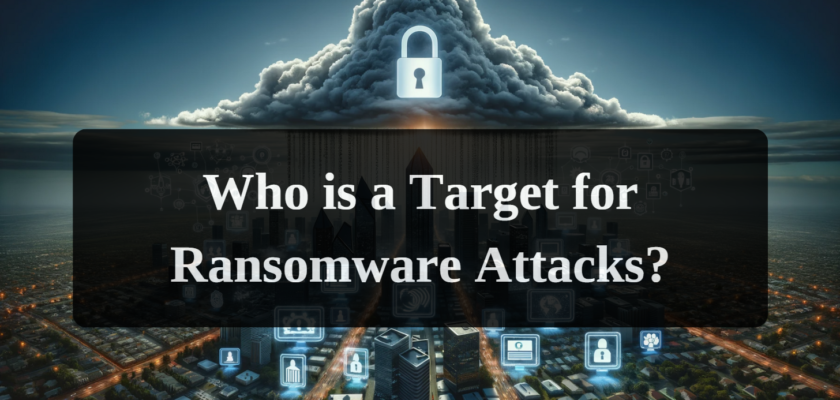In the rapidly evolving realm of cyber threats, one category has emerged as particularly menacing and pervasive: ransomware attacks. The question of “Who is a target for ransomware attacks?” no longer has a straightforward answer. In today’s digital age, virtually every entity, from small businesses and medium-sized enterprises to large corporations and government institutions, is susceptible to the looming threat of ransomware. Recent high-profile incidents, including the notorious WannaCry and Petya attacks, have demonstrated that ransomware knows no bounds, and its impact reverberates across various sectors.
Ransomware Attack Victims
Large Corporations and Enterprises
Large corporations and enterprises have long been prime targets for ransomware attacks. Often, the motivation for attackers is financial gain, and these attacks can yield cybercriminals millions, if not billions, of dollars. Notable cases include the WannaCry attack, which paralyzed thousands of computers and demanded ransom in bitcoins, and REvil, which demanded a substantial ransom from the American IT company Kaseya.
Large corporations, often operating in critical sectors such as finance, energy, and healthcare, are of particular interest to attackers. Data availability in these sectors is critical, and the disruption of systems can lead to significant financial losses and societal disruptions.
Small and Medium-Sized Enterprises (SMEs)
Small and medium-sized enterprises (SMEs) are not immune to ransomware threats. At first glance, they may appear to be less attractive targets than large corporations, but in reality, they often become vulnerable targets. Attackers perceive that SMEs may lack adequate cybersecurity measures, making them easy prey.
Furthermore, SMEs can act as weak links in the supply chain. If attackers successfully compromise a supplier, it can lead to supply chain disruptions and significant financial losses for larger corporations that depend on their services or products.
Government and Municipal Institutions
Government and municipal institutions have also become active targets for ransomware attacks. These attacks can have far-reaching political and social consequences. Attackers may block access to critical information or threaten to disclose confidential data.
An example is the attack on the City of Atlanta’s municipal government in the United States in 2018. The attack paralyzed the city’s systems, including healthcare and law enforcement services. Attackers demanded a ransom in bitcoins in exchange for decryption keys, resulting in a multimillion-dollar payment. This incident underscored the importance of protecting government and municipal institutions.
Individual Users
Ransomware attacks can also be devastating for individual users. Attackers can encrypt personal files and demand a ransom in exchange for decryption keys. Common attack methods include phishing emails, malicious websites, and malicious attachments.
For individual users, the damage from ransomware attacks can be immense. They may lose access to important documents, photos, videos, and other personal data, which may not hold monetary value for attackers but carry great personal significance.
Specific Industries
Some industries are more susceptible to ransomware risks due to their nature and importance to society and the economy.
Financial Sector: Financial institutions such as banks, exchanges, and investment firms attract the attention of cybercriminals. These organizations handle vast amounts of financial transactions and possess critical customer data. Attacks on the financial sector can lead to financial panic and economic disruptions.
Manufacturing and Energy: Industrial enterprises and energy companies are also attractive targets. Attacks on these sectors can halt manufacturing processes and disrupt energy supplies. This can have far-reaching consequences for national security and the economy.
Healthcare: The healthcare sector contains a wealth of sensitive patient medical data and has become a target for ransomware attacks. Attacks on healthcare institutions can result in the blocking of access to patient medical records and even the suspension of medical procedures. This poses serious risks to health and safety.
Trends and Statistics
Recent statistical data indicate a growing trend of ransomware attacks worldwide. Reports show an increasing number of attacks and ransom demands. These attacks are becoming more sophisticated and targeted, often involving social engineering and tailored phishing.
There is also a concerning trend of exploiting vulnerabilities in critical infrastructure, such as energy systems and transportation networks, for further ransomware attacks. This poses a threat to national security and underscores the importance of cybersecurity in these sectors.
Conclusion
Understanding the targets of ransomware attacks is a key element in ensuring cybersecurity in the modern world. Whether you are a large corporation, an SME, a government institution, or an individual, taking precautions and staying informed about cybersecurity updates is crucial.
Collaboration, information sharing, and cybersecurity education are becoming increasingly important in combating ransomware attacks. Only through collective efforts can we make the digital world safer and more resilient against this serious cyber threat.

